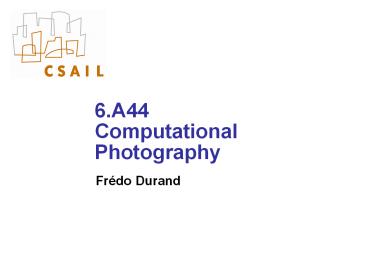6.A44 Computational Photography PowerPoint PPT Presentation
Title: 6.A44 Computational Photography
1
6.A44 Computational Photography
- Frédo Durand
2
My Background
- Mathematics CS
- PhD in Computer Science, 3D computer graphics
- Grenoble University, France
- Theory applications
- Read a lot about visual perception
- A little bit about art history
- A little bit about photography
3
Computer Graphics - Frédo Durand
Real-time Realistic Rendering
Non-Photorealistic Rendering
ComputationalPhotography
4
Real-time and realistic rendering (Frédo Durand)
- Better
- Appearance
- Lighting
- Shadows
- Faster
- Visibility
- Simplification
- New real-time architectures
- Software Hardware
Shadow map
Our technique
5
Frequency analysis of light transport
6
Ray tracing with bandwidth prediction
Curvature BRDF
Blocker distance
7
Non-Photorealistic Drawing (Frédo Durand)
8
(No Transcript)
9
Computational photographyFrédo Durand
- 1st digital revolution (done!)Ease of taking and
sharing pictures - 2nd digital revolution (just starting!) Image
quality enhancement exploiting power of digital
processing
10
Tonal management
- Over and under-exposure is the largest cause of
bad photographs - Both for professional and consumers
11
High Dynamic Range
- Real-world contrast is high
- Display contrast is low
10-6
106
High dynamic range
Real world
10-6
106
Picture
Low contrast
12
Our approach
- Reduce contrast of large scale preserve local
detail - Non-linear image decomposition
Output
Large-scale
Detail
Color
13
Flash Photography (Elmar Eisemann)
- Available light is not always enough, image is
blurry/noisy
14
Flash Photography (Elmar Eisemann)
- Available light is not always enough, image is
blurry/noisy - Flash photos look harsh, ambiance is not nice
15
Flash Photography (Elmar Eisemann)
- Available light is not always enough, image is
blurry/noisy - Flash photos look harsh, ambiance is not nice
- Our work combines the two to get the best of both
16
Flash Photography (Elmar Eisemann)
No-flash
Flash
Result
17
Non-Photorealistic Drawing (Frédo Durand)
18
Image-based modeling and photo editing
- With Byong Mok Oh, Max Chen and Julie Dorsey
- 3D model from single photograph
- User-driven
- Photo editing with power of 3D
- Change objects, texture, lighting
Input image New viewpoint
Relighting
19
Results Hotel Lobby
20
Style 2D from 3D Fun with Salvador Dali
21
Motion magnification
22
(No Transcript)
23
Photography hobby
24
(No Transcript)
25
(No Transcript)
26
(No Transcript)
27
(No Transcript)
28
(No Transcript)
29
(No Transcript)
30
Photoshop
31
Who you are
32
Brainstorming seminar content
33
Seminar format
34
Books
- No required textbook
- I will use many books and web resources
35
Museum of Fine Arts exhibit
36
Pinhole imaging
37
Pinhole limit
38
Lens
- Gather more light!
- Two new important issues
- Aperture size
- Focusing distance
Point in focus
lens
sensor
39
Lenses
24mm
50mm
135mm
40
Perspective vs. viewpoint
- Focal lens does NOT ONLY change subject size
- Same size by moving the viewpoint
- Different perspective (e.g. background)
Snapshot-Perspective-Speed, aperture-Filter-Lighti
ng-Processing Print-Make up-Retouching
41
Perspective vs. viewpoint
- Martin Scorcese, Good Fellas
Snapshot-Perspective-Speed, aperture-Filter-Lighti
ng-Processing Print-Make up-Retouching
42
Perspective vs. viewpoint
- Portrait distortion with wide angle
Wide angle
Standard
Telephoto
Snapshot-Perspective-Speed, aperture-Filter-Lighti
ng-Processing Print-Make up-Retouching
43
Exposure
- Two main parameters
- Aperture (in f stop)
- Shutter speed (in fraction of a second)
44
(No Transcript)
45
Exposure
- Two main parameters
- Aperture (in f stop)
- Expressed as a fraction of the focal length
- E.g. f/2.0 for a 50mm lens means an aperture of
25mm - Longer lenses need bigger aperture
- Shutter speed (in fraction of a second)
- Reciprocity
- The same exposure is obtained wit an exposure
twice as long and an aperture half as big - Hence square root of two progression of f stops
- Reciprocity can fail for very long exposures
46
Depth of field
Point in focus
lens
sensor
Object with texture
47
Depends on aperture
48
Depth of field
- Depends on aperture and lens
- Selective focus
Snapshot-Perspective-Speed, aperture-Filter-Lighti
ng-Processing Print-Make up-Retouching
49
Depth of field
- Complete focus
- Never happensfor human vision
Snapshot-Perspective-Speed, aperture-Filter-Lighti
ng-Processing Print-Make up-Retouching
50
(No Transcript)
51
Depth of field
- Selective focus
- In reality, we would beable to shift focus
- This is refused to us
- The photographer rules
Snapshot-Perspective-Speed, aperture-Filter-Lighti
ng-Processing Print-Make up-Retouching
52
Depends on focusing distance
53
Depends on focal length
- Remember definition of f stop
54
Depth of field
- Its all about the size of the lens aperture
Point in focus
lens
sensor
Object with texture
lens
sensor
Point in focus
Object with texture
55
The Print
56
Traditional craft dodging and burning
- Negative has more range than print (data-rich!)
- Locally darken or lighten
- Mask to expose some areas less
- Has to be done for each print!
- Risk of halo artifacts
maskshadow
mask
projector
burning
dodging
57
Traditional craft dodging and burning
- Clearing Winter Storm by Ansel Adams
After dodging and burning
Straight print
58
Assignment 1 Aperture/Speed
- Four pictures
- Shallow depth of field to isolate the subject
- Long depth of field to relate elements at
different depths - Fast shutter speed to freeze motion
- Slow shutter speed for motion blur

